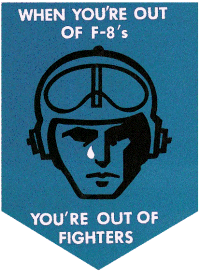Vought F-8 Crusader
Role: carrier-borne fighter
Builder: Chance-Vought, Ling-Temco-Vought (LTV) Aerospace
Variants: F8U-1 (F-8A), F8U-1P (RF-8A), F8U-1T (TF-8A), F8U-1E (F-8B), F8U-2 (F-8C),
F8U-2N (F-8D), F8U-2NE (F-8E), RF-8G, F-8H, F-8J, F-8K, F-8L, F-8E(FN)
Operators*: US Navy, US Marine Corps, Philippines, French Navy
* past
The F-8 Crusader was the first supersonic carrier based fighter. The design features a variable incidence wing to permit lower landing speeds. Originally a dayfighter but later variant were also capable of flying all-weather operations. It was extremely well liked by its pilots and, because of its agility, was considered one of the most potent combat aircraft of the Vietnam War. Before the tri-service the F-8 Crusader was designated F8U. The Crusader is considered to be the last true dogfighter, equipped with four 20mm cannons as it primary weapons and two or four short range air-to-air missiles like the AIM-9 Sidewinder as secondary.
A re-equipped version of the F8U-1 was converted to dedicated photo reconnaissance aircraft without any guns. First designated F8U-1P and later receiving the tri-service designation of RF-8A, it earned the title 'Eyes of the Fleet' being the carrier's primary reconnaissance platform. The later RF-8G recce version served with the US Navy until 1986, much longer than the fighter variant.
The F-8E(FN) Crusaders was the F-8E version for the French Navy of this successful carrier-based dogfighter, which remained in service with the AĆ©ronavale until the end of 1999 when it was being replaced by the Rafale M.
A total of 1305 Crusaders were built, see the History page for more information.




 Back to Index
Back to Index